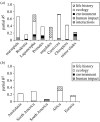The predictability of extinction: biological and external correlates of decline in mammals
- PMID: 18367443
- PMCID: PMC2602711
- DOI: 10.1098/rspb.2008.0179
The predictability of extinction: biological and external correlates of decline in mammals
Abstract
Extinction risk varies among species, and comparative analyses can help clarify the causes of this variation. Here we present a phylogenetic comparative analysis of species-level extinction risk across nearly the whole of the class Mammalia. Our aims were to examine systematically the degree to which general predictors of extinction risk can be identified, and to investigate the relative importance of different types of predictors (life history, ecological, human impact and environmental) in determining extinction risk. A single global model explained 27.3% of variation in mammal extinction risk, but explanatory power was lower for region-specific models (median R2=0.248) and usually higher for taxon-specific models (median R2=0.383). Geographical range size, human population density and latitude were the most consistently significant predictors of extinction risk, but otherwise there was little evidence for general, prescriptive indicators of high extinction risk across mammals. Our results therefore support the view that comparative models of relatively narrow taxonomic scope are likely to be the most precise.
Figures
References
-
- Balmford A. Extinction filters and current resilience: the significance of past selection pressures for conservation biology. Trends Ecol. Evol. 1996;11:193–196. doi:10.1016/0169-5347(96)10026-4 - DOI - PubMed
-
- Bielby J, Mace G.M, Bininda-Emonds O.R.P, Cardillo M, Gittleman J.L, Jones K.E, Orme C.D.L, Purvis A. The fast-slow continuum in mammalian life history: an empirical reevaluation. Am. Nat. 2007;169:748–757. doi:10.1086/516847 - DOI - PubMed
-
- Bininda-Emonds O.R.P, et al. The delayed rise of present-day mammals. Nature. 2007;446:507–512. doi:10.1038/nature05634 - DOI - PubMed
-
- Cardillo M, Purvis A, Sechrest W, Gittleman J.L, Bielby J, Mace G.M. Human population density and extinction risk in the world's carnivores. PLoS Biol. 2004;2:909–914. doi:10.1371/journal.pbio.0020197 - DOI - PMC - PubMed
-
- Cardillo M, Mace G.M, Jones K.E, Bielby J, Bininda-Emonds O.R.P, Sechrest W, Orme C.D.L, Purvis A. Multiple causes of high extinction risk in large mammal species. Science. 2005;309:1239–1241. doi:10.1126/science.1116030 - DOI - PubMed
Publication types
MeSH terms
LinkOut - more resources
Full Text Sources


